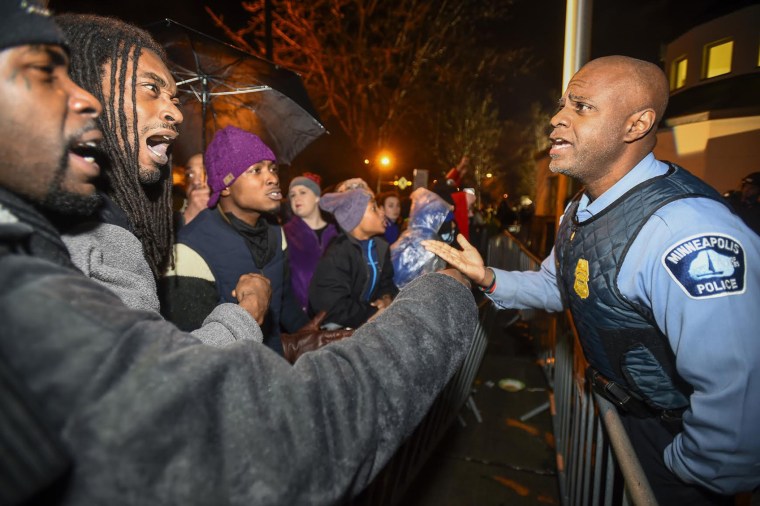Police and protesters in Minneapolis clashed for a second night following the death of Jamar Clark, an unarmed black man who was shot by police over the weekend and died at a local hospital on Monday.
Clark was shot during an apparent struggle with police on Sunday, shortly after officers responded to calls by emergency workers who said the 24 year old was reportedly interfering with their aiding of an assault victim. During the ensuing struggle police shot Clark in the head. On Monday, the man’s family took him off of life support.
RELATED: Minneapolis mayor seeks federal investigation into shooting
The Hennepin County Coroner’s office has declared Clarke’s death a homicide. The FBI has since launched a federal investigation parallel to a state investigation into the shooting.
Minneapolis — like Baltimore, Cleveland, New York City and Oakland, California, before it — is just the latest American city to become roiled in outrage and protests over the killing of unarmed African-Americans by the police since the 2014 killing of Michael Brown in Ferguson, Missouri. In the death of Clark, as well as a police shooting in Chicago of teenager Laquan McDonald, attention has focused on law enforcement's unwillingness to release video documenting the deadly incidents.
As with so many of those cases, possibly damning video may prove critical to cooling or ratcheting up tension between the police and the city's black community.
On Wednesday, as protests intensified in the city, police reportedly sprayed the crowd of protesters with some sort of chemical agent. They also arrested dozens of people who’d blocked traffic on an Interstate and allegedly hurled bricks and bottles at police. Protests began shortly after the shooting and have continued as police and witness accounts of the incident differ.
Witnesses have said that Clark was handcuffed at the time of the shooting or that he had his hands behind his back when he was shot. Police have contradicted those accounts.
The two officers involved in the shooting — officers Mark Ringgenberg and Dustin Schwarze — both of whom are white, have been placed on leave pending further investigation.
Clark’s family and a growing number of protesters have demanded police release video that may show some or all of what happened. Earlier this week, state officials said they would not release any video of the incident while they continue to investigate the shooting.
Superintendent Drew Evans Minnesota Bureau of Criminal Apprehension, which is investigating the case, told reporters that “We don’t want to taint the interviews that may be ongoing with witnesses in the case.” He suggested that would happen were the video to go public at this point.
On Wednesday, protests outside of the city police department took a dramatic turn when police attempted to clear protesters from a camp site they’d erected. The protesters had said they planned on staying at the site until the video was released, among other demands.
RELATED: Two Louisiana officers arrested in fatal shooting of boy
Meanwhile, in Chicago, another fight for the release of evidence in the police killing of another young black man is heating up.
On Oct. 20, 2014, 17-year-old McDonald died in a hail of police bullets on the city’s Southside. He was struck with more than 15 police bullets. Chicago police said McDonald was shot after he lunged at officers with a knife and refused to drop it. Police said they had tried to detain him while responding to reports of a man acting erratically outside of a fast-food restaurant.
As in the case of the shooting in Minneapolis, Chicago police refused to release dashcam video of the killing — which reportedly shows McDonald being shot down and shot again as he lay on the ground dying — because they do not want to compromise an ongoing investigation and grand jury probe into the case.
Journalists, Chicago’s law department, an independent police watchdog group, and Illinois Attorney General Lisa Madigan have all either asked for the release of the video or filed Freedom of Information Act requesting its release — but in each instance the police department has refused.
An opinion released earlier this month by Madigan's office said the Chicago Police Department has violated the state’s Freedom of Information Act and that it should “promptly provide” the video allowing the redaction of any private information that may be included. On Wednesday, the city’s law department issued a statement that the city would release the video once the criminal investigation is complete.
A judge is scheduled to make a ruling on Thursday afternoon in the case of one of the journalists requesting the release of the McDonald video.
There is also some concern that the release of what is likely highly incendiary footage could spark widespread unrest in the city.
In April, the City Council approved a $5 million settlement for McDonald’s family. The city’s Corporation Counsel reportedly said what was seen on the video was crucial to the decision to settle the case so early. According to The Chicago Tribune, Clark’s family and lawyers have seen the video and have declined to release it.
